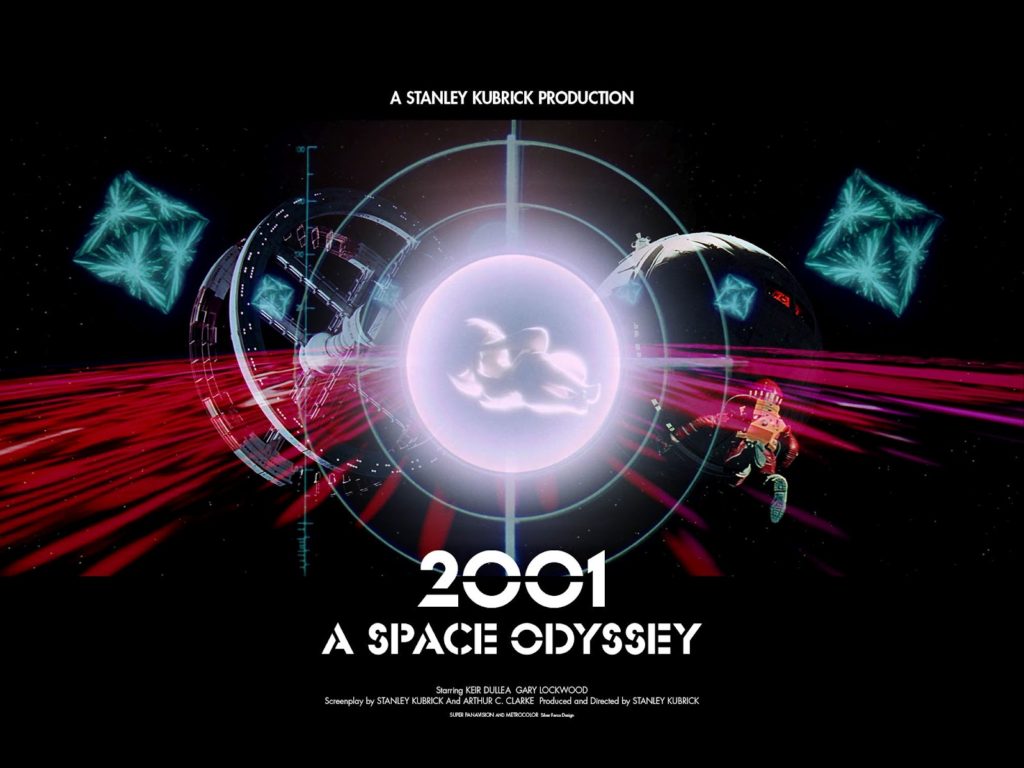Towards the end of a BFI IMAX Waterloo screening of Stanley Kubrick’s highly influential science-fiction classic 2001: A SPACE ODYSSEY, I could hear a female voice ask seated behind me:
‘What’s going on?’
Well, she is not alone in asking that question, as it’s one which millions of viewers of the film, be it on the big-screen, on TV, or on Home Entertainment and Cable / Satellite, have asked from time to time.
2001 is one of the most re-issued films in history, alongside the likes of GONE WITH THE WIND and Disney’s SNOW WHITE AND THE SEVEN DWARFS. It is, in turns, fascinating and frustrating. Fascinating in that it remains one of the most amazing technical productions – laden with ground-breaking effects techniques and style – but frustrating in that it doesn’t follow in principle any particular straightforward narrative that audiences can tap in to.
Based on a short story by Arthur C. Clarke, THE SENTINEL and announced originally in 1964 as JOURNEY BEYOND THE STARS, the film was shot for the most part at MGM Studios (now Elstree, where STAR WARS and RAIDERS OF THE LOST ARK were later filmed), utilising a mix of front-projection and physical technique, coupled with clever camera magic and set design. Photographed by Geoffrey Unsworth, who shot SUPERMAN a decade later, and featuring ape make-up from Stuart Freeborn, who went on to design some of the simulated animal and alien design in the original 1976 version of THE OMEN and STAR WARS, it was conceived by Kubrick as a purely visual experience.
The plot as such takes place across millions of years of evolution, opening in ‘The Dawn of Man’ where apes are mere simple beings, but the sudden appearance of a gigantic black rectangular monolith inspies the apes to evolve and take their first steps towards mankind. Millions of years later, the same monolith is discovered by a lunar research team, led by Dr. Heywood Floyd (William Sylvester).
Eighteen months later, an exploration vessel, the ‘Discovery’, captained by Mission Commander David Bowman (Keir Dullea) and Astronaut Frank Poole (Gary Lockwood), is en route to Jupiter. The ship is run by the most advanced computer of it’s kind, the HAL 9000 (voiced by Douglas Rain). An additional trio of astronauts are in deep hibernation, to be woken when Jupiter is in range.
However, HAL is demonstrating signs of misjudgement. As a result, Bowman and Poole decide to take action to try and salvage the mission. Unfortunately, HAL feels he is a little more advanced….
2001 is a movie that at it’s best is something that demands to be seen on the biggest screen possible. According to what I was told at the screening, the print on show appeared to be from the same release version that celebrated the official 2001 anniversary. Technically, the print was faultless both in terms of picture and sound and it played in it’s original roadshow presentation, complete with Intro, Intermission and Outro.
Having seen the film in 70mm several times over the year and initially on it’s Christmas 1981 BBC screening when it was in a pan and scan version, the movie is something I revisit from time to time, but even after nearly four decades of viewing, it still poses more questions than answers amidst it’s ambiguous nature. Perhaps this was something Kubrick deliberately intended when he made the film, to allow the audience to make up their mind on their own terms.
One fascinating story I learned from a Film Editor years ago was that the reason the film was so successful on it’s original 1968 release was that people were taking acid (Hence the original movie tag-line ‘THE ULITMATE TRIP’) and participating into repeat viewings.
One of the most famous stories involved the film’s original composer Alex North, who composed the music for Kubrick’s SPARTACUS. He had written and created music, before Kubrick decided to use the now-familiar classical music of ALSO SPRACH ZARATHUSTRA and THE BLUE DANUBE. This became a common usage for other film-makers and 2001 has influenced numerous, including James Cameron, George Lucas, Christopher Nolan and Steven Spielberg, who was responsible for completing one of his unrealised projects, A.I – ARTIFICIAL INTELLIGENCE.
In the case of Lucas, he is quoted on the reissue of 2001 in 1978 as saying that the film is ‘The Ultimate Sci-Fi movie’ and was determined to come up with something different when he made A NEW HOPE.
So, how does the film stand up half-a-century after it’s original release?
It certainly will continue to attract packed houses and the fact that it has reached a half-century of release, with countless screenings that remain popular, will heighten a desire from audiences to continue to see the film. However, one cannot feel that the same mix of bemusement, curiosity and disappointment will always fill audiences’ minds after they see it.
The effects are the key strength and the mid-section involving Bowman and Poole is the most riveting piece of the narrative and it does pose some interesting questions about the nature of evolution and intelligence.
Given the developments in space travel and moon travel that 2001 was on the cusp of at it’s original production, the design and effects make this an amazing visual experience overall, but the narrative will continue to throw people consistently.
If you fancy reading about the effects, you can read about them in the fascinating compendium, THE STANLEY KUBRICK ARCHIVES, published by Taschen, which contains fascinating insights into all of Kubrick’s across his career, plus some amazing photos and production notes.
































